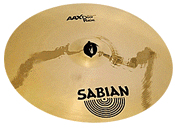"A good drummer listens as much as he plays." ~ Indian Proverb
Percussion Store Drummers Drum Lessons Drumming FAQs
International Shipping"A good drummer listens as much as he plays." ~ Indian Proverb
Percussion Store Drummers Drum Lessons Drumming FAQs
International Shipping
![]()
Drums & Percussion
Drum Sets & Cymbals
Cymbals, Hardware & Accessories
Latin Percussion
LP Hardware, Accessories & Replacement Parts
African Drums & Accessories
Gongs & Tam Tams
Middle-East Drums & Percussion
Doumbeks, Darbukas & Accessories
Indian Drums & Percussion
Irish Drums & Percussion
Orchestra Bells & Chimes
Drum & Percussion Hardware
![]()
Tips & Techniques

Treating your cymbals with care,
including setting them up properly on your stand and choosing the 'right' cymbal
size and weight for you musical style necessarily reduces the risk for damage.
Here are 7 great tips to extend the life of your cymbals:
1. Play the right cymbals. Every cymbal has its strengths and
limitations. Hitting a smaller or thinner cymbal harder and harder to get a
bigger sound or make it louder isn't the answer - it wasn't designed to be so
loud. So don't use small, thin cymbals for high-volume, hard-hitting playing
(unless you want a contrast in your set-up... but don't hit them as hard as the
rest.) For volume, power and durability, choose bigger and heavier models. And
consider the brighter sounding series, like AA, AAX, PRO and Sonix®. Their
sounds are higher pitched and more effective at cutting through a loud band.
Lower pitched series, like Hand Hammered and HHX, also offer models suitable for
powering any style of music.
2. Prepare your stands. No cymbal stand is complete without the
following:
A nylon or plastic tube over the center rod so the metal of the stand doesn't hurt the cymbal and from the bottom of the cymbal tilted to the top;
A metal support washer to prevent the cymbal from sliding down too far. Felt on top* of the metal washer, under the cymbal, to prevent metal-to-metal contact then add the cymbal before topping it off with;
A felt on top of the cymbal*A wing nut that isn't tightened down too tight
*Use smaller felts on smaller cymbals (splashes, hi-hats, etc.)
3. Do not over-tighten the cymbal. A cymbal must be free to vibrate.
Vibrations are what generate sound in the metal. The looser the cymbal, the
better the sound. Tightening it will kill that sound... choking it the same way
as if it was being held, or dampening it in much the same way as a piece of
tape. If the cymbal isn't free to move, then the pressure of your playing
creates stress in the metal and that can create cracking. Cracking due to
over-tightening usually happens around the base of the bell or straight in from
the edge.
4. Do not over-angle crash cymbals. These cymbals should be positioned
fairly flat and angled only slightly toward you, so your stick can slice across
their edge. A cymbal that is angled too steeply is restricted from moving freely
and it will suffer the same stress as if it were bolted down too tight. This
will restrict the sound and can lead to cracking.
5. Play your crash cymbals correctly. The edge of the cymbal is meant to
be 'crashed', but there are two things you can do to get the most and best sound
out of your crashes plus avoid cracking them:
7. Clean Your Cymbals: Cleaning your cymbals once or twice a year (or when needed) is another way to protect, restore and extend the life of your cymbals. Cleaning can also be a way to gain greater insight into the design, materials and manufacturing process of your cymbals.